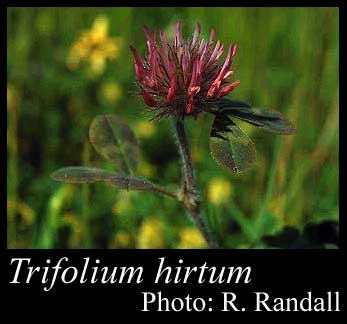- Reference
- Auct.Fl.Pedem. 20-21 (1789)
- Conservation Code
- Not threatened
- Naturalised Status
- Alien to Western Australia
- Name Status
- Current
Robust, erect or decumbent, villous annual, herb, to 0.3 m high. Fl. red-pink/purple, Aug to Dec or Jan to Mar. White-grey sand, brown sandy clay-loam, yellow sandy clay, sandstone, limestone, granite. Sand dunes,hills, plains.







Distribution
- IBRA Regions
- Avon Wheatbelt, Coolgardie, Esperance Plains, Geraldton Sandplains, Jarrah Forest, Mallee, Swan Coastal Plain, Warren.
- IBRA Subregions
- Fitzgerald, Geraldton Hills, Katanning, Lesueur Sandplain, Merredin, Northern Jarrah Forest, Perth, Southern Cross, Southern Jarrah Forest, Warren, Western Mallee.
- IMCRA Regions
- Leeuwin-Naturaliste.
- Local Government Areas (LGAs)
- Armadale, Beverley, Broomehill-Tambellup, Bruce Rock, Bunbury, Busselton, Capel, Chittering, Cockburn, Cranbrook, Dandaragan, Denmark, Gnowangerup, Goomalling, Harvey, Jerramungup, Joondalup, Kalamunda, Kellerberrin, Kojonup, Kondinin, Kulin, Lake Grace, Melville, Mingenew, Moora, Mount Marshall, Mukinbudin, Murray, Nannup, Narembeen, Nedlands, Northampton, Perenjori, Perth, Plantagenet, Ravensthorpe, South Perth, Swan, Three Springs, Victoria Plains, Wagin, Wanneroo, Wyalkatchem, York.
Management Notes (for the Swan NRM Region)
Alternative Names. Rose Clover.
General Biology. Growth form. Herb. Life form. Annual. Reproduction. Seed. Dispersal. Agricultural activities, contaminated seed, shoes, tyres, clothing, livestock (ingestion). Seedbank persistence. Several years.
Notes. Can compete with native herbs and grasses, and prevent establishment of other plant species due to its use of available soil moisture. Has low germination rates in unsuitable environmental conditions. Well adapted to acidic and mildly alkaline soils with low fertility in southern Australia and to climates with winter-dominant annual rainfall greater than 300 mm. Reported low levels of nitrogen fixation may have discouraged its agricultural use in Australia. Not suited to poorly-drained soils, relatively tolerant of drought and intolerant of soil salinity. Has a high proportion of hard seed which lose dormancy at very slow rates. Regenerates well from the soil seed bank with rainfall after summer drought.
Additional information. Origin. Mediterranean, Asia. History of use/introduction. Forage. Similar exotic species. Trifolium species.
Suggested method of management and control. Spot spray with 1% glyphosate before flowering. Otherwise spot spray Lontrel® 3 ml/10 L (150 ml/ha) up to 6 leaf stage. Read the manufacturers' labels and material safety data sheets before using herbicides. For further information consult the Australian Pesticides and Veterinary Medicines Authority to determine the status of permits for your situation or state.
Management Calendar
| Calendar Type | Jan | Feb | Mar | Apr | May | Jun | Jul | Aug | Sep | Oct | Nov | Dec | Comments |
|---|---|---|---|---|---|---|---|---|---|---|---|---|---|
| Germination | Y | Y | |||||||||||
| Active Growth | Y | Y | Y | Y | Y | Y | Y | ||||||
| Flowering | O | O | O | Y | Y | Y | Y | Y | |||||
| Fruiting | U | U | U | O | U | U | U | ||||||
| Optimum Treatment | Y | Y | O |
Legend: Y = Yes, regularly, O = Occasionally, U = Uncertain, referred by others but not confirmed.
References
- Brockwell, J., Fettell, N.A., Bownman, A.M., Smith, W., Sweeney, G., Charman, N. & Ballard, R.A. (2008) Symbiotic competence of rose clover (Trifolium hirtum All.). Australian Journal of Agricultural Research, 59 (9): 802–813.
- Brown, K. & Brooks, K. (2002) Bushland Weeds: A Practical Guide to their Management. Environmental Weeds Action Network, Greenwood.
- Brusati, E. & DiTomaso, J. (2003) California Invasive Plant Inventory Assessment Form, Trifolium hirtum All. California Invasive Plant Council URL: http://www.cal-ipc.org/ip/inventory/PAF/Trifolium%20hirtum.pdf - Accessed May 2010.
- Can, E., Celiktas, N., Hatipoglu, R. & Avci, S. (2009) Breaking seed dormancy of some annual Medicago and Trifolium species by different treatments. Turkish Journal of Field Crops, 14 (2): 72-78.
- Frame, J. (Undated) Trifolium hirtum All. Food and Agriculture Organization of the United Nations URL: http://www.fao.org/ag/agp/agpc/doc/gbase/data/Pf000501.htm - Accessed May 2010.
- Hussey, B.M.J., Keighery, G.J., Dodd, J., Lloyd, S.G. & Cousens, R.D. (2007) Western Weeds. A guide to the weeds of Western Australia. 2nd Edition. The Plant Protection Society of Western Australia, Victoria Park.
- Jain, S.K. & Martins, P.S. (1979) Ecological genetics of the colonizing ability of Rose Clover (Trifolium hirtum All.). American Journal of Botany, 66 (4): 361-366.